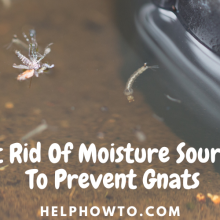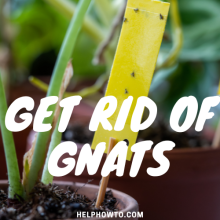Stop Gnats Breeding In Drains And Sinks | HelpHowTo
Summary of Stopping Gnats Breeding in Drains and Sinks
Drain gnats are tiny pests that breed rapidly in the organic matter buildup found in drains, sinks, and sewers. Understanding their life cycle from eggs to larvae to adults is key to controlling infestations. Preventative measures include regularly cleaning drains, sealing entry points, and using enzymatic cleaners to eliminate breeding grounds. For existing infestations, chemical drain cleaners, boiling water flushes, removal traps, and mechanical tools can eliminate larvae.
Eco-friendly options include vinegar, baking soda, essential oils, saltwater flushes, and plant-based insecticides. Preventing future issues requires routine plumbing inspections, proper food storage, and promptly fixing moisture sources. Maintaining a gnat-free environment involves consistent drain cleaning, monitoring for activity, and continued trap use if needed. With an integrated approach of prevention, targeted treatment, and vigilant maintenance, homeowners can effectively control these rapidly multiplying nuisance pests.

Our Top 5 Recommended Indoor Genat Traps
Sick of pesky gnats invading your home? Discover the top 5 indoor gnat traps to banish these annoying insects for good! Our expert reviews reveal the most effective, easy-to-use traps. From powerful UV attractants to eco-friendly vinegar traps, we’ve thoroughly tested and ranked the best solutions. Check Now

Dealing with Drain Gnats: A Comprehensive Guide to Eliminating These Pesky Pests
Drain gnats, also known as sink flies or sewer flies, are tiny nuisance pests that can quickly turn into a big problem in homes. These small, moth-like insects breed in the moist, organic matter that accumulates in drains, sinks, and sewers. While they don’t bite, drain gnats can spread bacteria and contaminate food surfaces, making it crucial to control their population. Moreover, their larvae can clog pipes, leading to plumbing issues. This comprehensive guide will explore strategies to prevent and eliminate drain gnat infestations effectively.
Understanding the Drain Gnat Life Cycle:
To combat drain gnats successfully, it’s essential to understand their life cycle. Adult female gnats lay their eggs in the thin film of organic matter lining drains and sinks. These eggs hatch into small, cylindrical larvae that feed on the decaying matter. After several molts, the larvae pupate and eventually emerge as adult gnats. The entire life cycle from egg to adult can take as little as 8-10 days in optimal conditions, allowing populations to explode rapidly.
Preventative Measures:
The key to controlling drain gnats lies in prevention. By eliminating their breeding grounds, you can significantly reduce the chances of an infestation. Here are some preventative strategies:
- Maintain clean drains and sinks: Regularly flushing drains and sinks with hot water and using enzymatic or bacterial drain cleaners can break down organic matter buildup, removing potential breeding sites.
- Seal entry points: Caulk cracks or gaps around drains and pipes to prevent gnats from entering and laying eggs. Installing drain covers or screens can also help block access.
- Vinegar and baking soda: A simple mixture of vinegar and baking soda can effectively clean drains and sinks, removing organic matter that attracts gnats.
- Enzymatic cleaners: Commercial enzymatic drain cleaners use beneficial bacteria to break down organic matter, making it an excellent preventative measure.
Downsides: While preventative measures are essential, they may not entirely eliminate an existing infestation. Some chemical drain cleaners can be harsh on pipes and the environment, and regular maintenance is required to keep drains and sinks clean.
Eliminating an Existing Infestation:
If you’re already dealing with a drain gnat infestation, more aggressive measures may be necessary. Here are some effective methods:
- Chemical drain cleaners: When used with caution, chemical drain cleaners can kill drain gnat larvae and adults. However, they should be handled with care and proper ventilation.
- Boiling water: Pouring boiling water down affected drains can effectively kill larvae and disrupt their breeding cycle.
- Removal traps: Simple traps made from apple cider vinegar and a few drops of dish soap can attract and drown adult gnats, reducing their population.
- Mechanical removal: Using tools like drain brushes, snakes, or zip-it tools can physically remove larvae and organic matter from drains.
Downsides: Chemical drain cleaners can be harsh and potentially harmful if not used properly. Mechanical removal may not eliminate all larvae and organic matter, allowing the infestation to persist.
Natural Remedies:
For those seeking eco-friendly alternatives, several natural remedies can effectively control drain gnats without harsh chemicals:
- Vinegar and baking soda: The acetic acid in vinegar and the abrasive nature of baking soda can kill larvae and remove organic matter.
- Essential oils: Peppermint, tea tree, or eucalyptus essential oils have insecticidal properties and can be poured down drains to repel gnats.
- Salt water flush: A saltwater solution can dehydrate and kill larvae when flushed down drains.
- Bacterial/enzymatic cleaners: These eco-friendly cleaners use beneficial bacteria to break down organic matter, eliminating breeding grounds.
- Plant-based insecticides: Neem oil and pyrethrin, derived from plants, are effective natural insecticides that can target drain gnat larvae and adults.
Downsides: Natural remedies may not be as potent as chemical treatments and may require consistent application for complete elimination.
Preventing Future Infestations:
Even after successfully eliminating an infestation, it’s crucial to take preventative measures to avoid a recurrence:
- Routine plumbing inspections: Regular inspections can identify and address potential breeding grounds before they become a problem.
- Proper food storage and disposal: Keeping kitchens clean and storing food properly can limit the organic matter available for gnats to breed.
- Eliminating moisture sources: Immediately addressing leaks, standing water, or excessive moisture can prevent new breeding sites from forming.
Maintaining a Gnat-Free Environment:
Continuous vigilance is key to maintaining a gnat-free environment after an infestation:
- Regular drain cleaning routine: Establish a consistent schedule for cleaning drains and sinks with enzymatic cleaners or natural solutions.
- Fix leaks promptly: Address any new leaks or moisture issues as soon as they arise to prevent breeding grounds from forming.
- Continued use of traps: If gnats persist, continue using removal traps to reduce their population.
- Monitoring for signs of return: Regularly inspect drains and sinks for any signs of organic matter buildup or gnat activity.
- Professional extermination: In severe or persistent cases, seeking the help of a professional exterminator may be necessary.
Conclusion:
Drain gnats may be small, but their ability to rapidly breed in drains and sinks can quickly turn them into a persistent nuisance. By understanding their life cycle and implementing an integrated approach combining preventative measures, targeted elimination methods, and ongoing maintenance, homeowners can effectively control and prevent these pesky pests. Remember, consistent efforts and addressing the root causes are key to achieving long-term success in keeping your home gnat-free.

Our Top 5 Recommended Indoor Genat Traps
Sick of pesky gnats invading your home? Discover the top 5 indoor gnat traps to banish these annoying insects for good! Our expert reviews reveal the most effective, easy-to-use traps. From powerful UV attractants to eco-friendly vinegar traps, we’ve thoroughly tested and ranked the best solutions. Check Now
FAQs and Answers
How can I identify if I have a drain gnat infestation or if it’s another type of fly?
Here are some tips to help identify if you have a drain gnat infestation or another type of fly:
Appearance:
Drain gnats (also called sink flies or sewer flies) are very small, just 1/8 inch long. They are fuzzy, moth-like flies with long antennae and grayish-black bodies.
Other small flies like fruit flies tend to be more smooth-bodied, while fungus gnats are darker black and more slender.
Behavior:
Drain gnats are primarily seen around drains, sinks, sewers, and other moist areas with organic buildup where their larvae develop. They tend to run across surfaces rapidly rather than fly.
Fruit flies are attracted to ripened fruits and vegetables, while fungus gnats are found around overwatered houseplants.
Check drains:
Pull out the drain cover or use a flashlight to look in sink and shower drains. If you see small worm-like larvae, these are likely drain gnat larvae feeding on the slimy buildup.
Monitor with tape:
Place pieces of tape coated with vegetable oil or petroleum jelly over drains overnight. If many small gnats are stuck to the tape in the morning, it indicates a drain infestation.
If the flies exhibit the small, fuzzy appearance, tendency to run across surfaces, and presence around drains, it’s a good indication it’s a drain gnat problem rather than another household fly infestation.
Can drain gnats harm my indoor plants or gardens?
Yes, drain gnats can potentially harm indoor plants and outdoor gardens, though the risk is relatively low compared to some other pests.
For indoor plants:
- The adult drain gnats are more of a nuisance than a serious threat, as they do not feed on or lay eggs in healthy plants.
- However, the larvae or immature drain gnats can potentially damage plant roots and stunt growth if they infest the soil of overwatered houseplants.
- The larvae feed on organic matter, fungi, and algae in the soil, disrupting the plant’s ability to absorb nutrients properly.
- Plants in consistently moist soil conditions are most vulnerable to drain gnat larvae infestation.
For outdoor gardens:
- Adult drain gnats typically do not travel far from their breeding sites indoors, so outdoor garden plants are less likely to be affected unless their roots are very close to an infested area.
- However, the larvae can potentially burrow into potted outdoor plants or damage seedlings if the soil contains high amounts of decaying organic matter that the larvae feed on.
- Overly moist soil conditions combined with compost or mulch buildup provides ideal breeding grounds that could attract drain gnats.
To protect plants, it’s recommended to allow soil to dry out between waterings, remove any decaying plant matter promptly, and consider using yellow sticky traps or biological controls like nematodes to reduce drain gnat populations if an infestation occurs. Maintaining proper soil drainage and avoiding overly moist conditions is key to discouraging drain gnats.
How effective are over-the-counter drain gnat traps and baits?
Over-the-counter drain gnat traps and baits can be moderately effective in controlling drain gnat populations, but they have their limitations and may need to be used in combination with other methods for complete elimination.
Effectiveness of Traps:
- Sticky traps, like tape or paper coated with a sticky substance, can catch adult gnats that emerge from drains. However, they do not address the larvae breeding in the pipes.
- Funnel traps that lure gnats in with bait (often apple cider vinegar) can capture a good number of adults, but may miss those deeper in the drains.
- Traps work best when larvae sources are minimal, otherwise gnats will continue emerging from undisturbed areas.
Effectiveness of Baits:
- Gel baits containing insecticides like pyrethrin or pyriproxyfen target both adult and larval stages of drain gnats.
- When applied directly to infested areas like drain openings, they can be quite effective at killing larvae and interrupting the breeding cycle.
- However, they may not penetrate deeply into pipes and cannot reach all organic buildup where larvae reside.
Pros:
- Convenient and easy to use
- Some are pesticide-free/lower toxicity options
- Can reduce adult gnat populations quickly
Cons:
- May need to be reapplied frequently
- Often don’t fully eliminate infestation at the source
- Insecticidal baits can be toxic if misused
For best results, traps and baits should be used in conjunction with thorough drain cleaning, removing built-up grime and moisture sources that foster breeding. They can be effective supplementary tools but may not provide complete control on their own for severe infestations.
Is it safe to use drain cleaners while pregnant or around children/pets?
Using drain cleaners while pregnant or around children and pets requires extra caution and precautions due to the potential risks involved.
Risks During Pregnancy:
Many conventional drain cleaners contain harsh chemicals like sodium hydroxide (lye), sulfuric acid, or hydrochloric acid that can be harmful if inhaled or exposed to the skin. These chemicals have been linked to potential reproductive and developmental risks if used improperly during pregnancy. It’s best to minimize exposure as a precautionary measure.
Risks to Children and Pets:
Drain cleaners pose poisoning risks if accidentally ingested by curious children or pets. The corrosive chemicals can cause severe burns or tissue damage if splashed in eyes or on skin. Children and pets may also be more sensitive to fume inhalation.
Safer Alternatives:
If drain cleaning is necessary during pregnancy or around kids/pets, consider using safer, natural alternatives first:
- Baking soda and vinegar mixture
- Enzymatic bio-drain cleaners
- Boiling water flushes
- Manual drain snakes/brushes
If Chemical Cleaners are Required:
- Use in a well-ventilated area
- Wear gloves and eye protection
- Keep children and pets away during use and until fumes fully dissipate
- Follow all product label instructions carefully
- Consider less toxic options like small amounts of borax or washing soda
It’s generally advisable to avoid harsh chemical drain cleaners during pregnancy when possible. If they must be used, take all safety precautions to minimize exposure risks to yourself and vulnerable populations like children and pets in the home.
How can I prevent drain gnats from spreading to other areas of my home?
Preventing drain gnats from spreading to other areas of your home requires containing the infestation and eliminating potential new breeding grounds. Here are some effective strategies:
- Locate and treat the source(s):
Thoroughly inspect and treat all drains, sinks, and pipes where gnats are breeding. Use a combination of drain cleaning methods like enzyme cleaners, boiling water flushes, and mechanical removal tools to eliminate larvae and organic matter buildup. - Seal entry points:
Caulk any cracks or gaps around drains, pipes, and plumbing fixtures that could allow gnats to move into new areas. Install drain covers or screens to block their movement. - Maintain dry conditions:
Drain gnats thrive in moist environments. Fix any leaks and dry out damp areas like basements or crawl spaces that could become new breeding sites. Use dehumidifiers if needed. - Limit food sources:
Clean up any spills and dispose of organic waste promptly. Store food in sealed containers and regularly take out the trash to limit potential food sources for wandering gnats. - Use sticky traps:
Place sticky trap monitors in areas outside the infestation zone to catch any gnats attempting to spread. Pay special attention to kitchens, bathrooms, and laundry rooms. - Use insecticide sprays cautiously:
As a last resort, consider using insecticide sprays labeled for flying insect control in areas outside the main infestation. Always ventilate well and follow product instructions carefully. - Seal rooms temporarily:
If infestation is confined to one area, seal off rooms by closing doors and windows while treating to prevent gnats from moving to new spaces.
Consistent monitoring and quickly addressing any new moisture sources or organic buildup is key. With diligence, you can contain drain gnats and prevent them from becoming an issue throughout your home.

Our Top 5 Recommended Indoor Genat Traps
Sick of pesky gnats invading your home? Discover the top 5 indoor gnat traps to banish these annoying insects for good! Our expert reviews reveal the most effective, easy-to-use traps. From powerful UV attractants to eco-friendly vinegar traps, we’ve thoroughly tested and ranked the best solutions. Check Now




